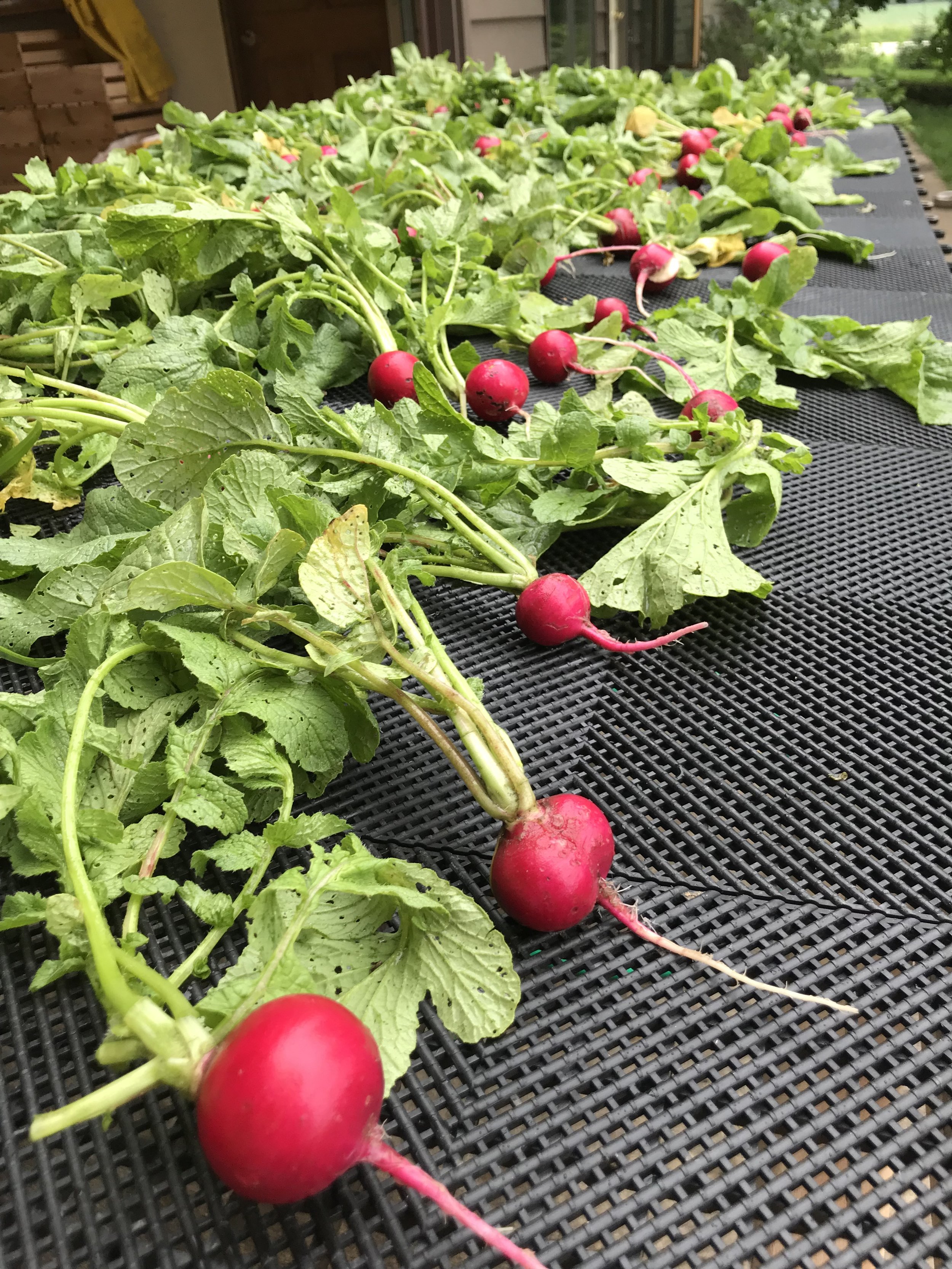Storage Tips for Produce
Here are some helpful tips for storing your produce for maximum longevity in your fridge. With most produce, the sooner you’re able to eat it, the better the flavor will be but we definitely understand how it can be difficult to eat all of the produce in just one week!
Arugula
Wrap leaves in a cloth or paper towel and place them in a perforated plastic bag in the vegetable crisper section of the refrigerator. Arugula will keep in the refrigerator for about 10 days but it will be most flavorful in used in 3 to 6 days.
bell peppers
Store unwashed peppers in a dry plastic bag in the refrigerator. Halve sweet peppers remove the core and seeds, and slice into julienne strips or small 1/4" chunks. Pack them into a freezer bag, squeeze out the air and throw them in the freezer.
carrots
Carrots can be stored for several months in the refrigerator or over winter in a moist, cool place. Twist off tops & refrigerate carrots in a plastic bag.
Sweet Corn
Use within 2-3 days. Place ears of corn in your refrigerator as soon as possible. Leave the husk on, if possible, and let the corn sit in the fridge uncovered. Keep the temperature at or below 40 degrees to reduce the amount of natural sugars in the corn from turning to starch at higher temperatures.
Garlic
Storing garlic uncovered, such as in a wire-mesh basket inside your cupboard or beneath a small overturned clay pot, is ideal. You can also store garlic in a paper bag, egg carton, or mesh bag. Just be sure there is plenty of dry air and little light to inhibit sprouting. To avoid mold, do not refrigerate or store garlic in plastic bags.
Kale
To store, keep kale refrigerated in an airtight bag. It can typically be stored for up to 5 days, but you may notice the flavor increase in bitterness with longer storage. Only wash the kale when you are ready to use it as washing before storage will promote spoilage.
melons
Despite their hardy appearance, melons are quite perishable. Keep ripe melons away from other fruit so that the ethylene gas that they produce does not speed up the fruit's ripening. Uncut ripe melons should keep in the fridge for up to 5 days. When storing a halved melon, leave the seeds in to help keep it fresh. Once you've cut into a melon, wrap the remainder in plastic and it should keep in the fridge for about 3 days.
parsley
Trim stems and store in a glass of water on the kitchen counter. If refrigerating, cover with a plastic bag.
Radish
If the radishes have their leaves intact, remove them and store the leaves separate from the roots. Radishes will keep well for up to 2 weeks if stored in the vegetable crisper of the refrigerator. Wrap in a damp cloth or a perforated plastic bag.
Strawberries
Wash strawberries only before eating them, wet berries are more apt to get moldy. Leave the stems on as long as possible. Keeping the stems on until you're about to eat the strawberries will prolong their shelf life. Remove any moldy berries immediately. Mold spreads easily, so it's best to remove any spoiled berries before they ruin the rest of the bunch.
tomatoes
Ripe tomatoes should be stored on the counter top in a cool kitchen then eaten or processed within a few days. Although lots of people suggest that storing them in the fridge negatively affects their texture and flavor, tests have shown that refrigeration after a few days is best to avoid rot. Bringing refrigerated tomatoes to room temperature improves flavor.
Basil
The key to keeping basil fresh and fragrant for days (and even weeks) is to NOT store it in the refrigerator. Basil leaves quickly turn black and slimy and lose their signature spicy sweet flavor when refrigerated. A better way to store them is in a jar of water on your kitchen counter top. Pinch the leaves from the stems, spread them on cookie sheets and freeze them. Transfer the frozen leaves to plastic containers and put them back into the freezer for use throughout the winter. Since basil has a high water content it cannot be dried like many other herbs, as it will turn black and lose its flavor. It will also turn black if chopped or bruised and exposed to air.
broccoli
Consume fresh broccoli as soon as you can as it will not keep long. To store, mist the heads, wrap loosely in damp paper towels, and refrigerate. Use within 2 to 3 days. Do not store broccoli in a sealed plastic bag. Raw broccoli requires air circulation. A perforated plastic bag is fine.
Chard
Place chard in a plastic bag—without washing it—and place it in the fridge.
Cucumbers
Cucumbers should be stored at room temperature – not in the refrigerator. Cucumbers are sensitive to temperatures below 50°F and may develop "chilling injuries" including water-soaked areas, pitting, and accelerated decay. If you must refrigerate your cucumbers, limit it to 1-3 days and eat them as soon as possible.
Garlic Scapes
Store in a plastic bag in the fridge.
kohlrabi
Kohlrabi bulbs will keep in your refrigerator's veggie drawer for several weeks.
onions
Store onions in a dry and dark place, at an even temperature. Store only onions that are mature and properly cured. Curing means they’ve had time in a warm dry place to set their skins. Place onion and garlic in separate mesh bags or a clean and dry wooden bin or waxed box. Don’t wash your onions or garlic before you store them. Keep them very dry. While in storage, check and cull them often to make sure the onions and garlic are not sprouting or developing soft spots. Remove and eat any damaged bulbs.
peas
Refrigerate in a plastic bag - do not wash until ready to use.
raspberries
Only rinse berries right before you use them. Water increases the likelihood they'll start to mold. Place them in a colander and rinse water over them instead of fully submerging them. A good tip is to refrigerate them for an hour or so when you bring them home from the market. They're easier to rinse when they've had a chance to firm up just a bit. After washing berries, let them rest in a colander in the refrigerator and another vessel that has some air circulation. This will help them dry out more considerably than if just placed in a bowl.
spinach
Store in a damp towel in a plastic bag for up to 1 week.
Winter Squash
For long-term storage, find a cool but not cold spot in your home with good air circulation. Clean and sanitize your squashes before storage, and keep them from touching. Check them often, and immediately remove any that start to look soft or subpar.
Beets
The refrigerator drawer is the perfect environment for roots. Keep them in a plastic bag to retain moisture. In large quantities, store beets in dark place that is 38-42 degrees F and 90 percent humidity. Common places that work well are a basement (away from the furnace), garage, root cellar, or a dark and cool closet or kitchen cupboard close to the floor.
cabbage
Refrigerate cabbage in a hydrator drawer. Do not remove the outer leaves before storage. Once the cabbage has been cut store in a plastic bag.
Cilantro
Store cilantro in a jar of water (like flowers in a vase) in the refrigerator with a bag over the leaves.
Dill
Do not wash dill before storing. Store in a bag in refrigerator for up to two weeks.
Green Beans
Store unwashed in a perforated plastic bag in the refrigerator. Best when eaten within a week.
lettuce
Store lettuce leaves or mixed greens in a plastic bag in the fridge. A paper towel placed in the bag to absorb condensation will increase storage time considerably. Whole heads can be stored in the same way, just wrap the entire head of lettuce in paper towels and pull off leaves as needed.
Oregano
Store in a plastic bag in the refrigerator for up to 3 days. If you place a slightly damp paper towel in the bag with the oregano and leave some air in the bag, it may extend the life up to 1 week. You may also extend the shelf life of fresh oregano by storing whole stems with leaves in a glass of water with a plastic bag loosely tented over the glass.
potatoes
Store potatoes in a cool, dark, well ventilated place. Colder temperatures lower than 50 degrees, such as in the refrigerator, cause a potato’s starch to convert to sugar, resulting in a sweet taste and discoloration when cooked. Don’t wash potatoes (or any produce, for that matter) before storing.
rosemary
Wrap loosely in plastic wrap and place in the warmest part of the refrigerator; one of the compartments in the door works perfectly. Do not wrap tightly or the trapped moisture may cause them to mold prematurely; many people like to add a crumpled paper towel to the bag as a safeguard. Do not rinse the herbs until just before using.
Summer Squash/Zucchini
Place Summer Squash in a plastic storage bag before refrigerating. Do not wash Summer Squash before refrigeration because exposure to water will encourage your Summer Squash to spoil. Summer Squash will remain fresh for up to 5 days when properly stored.
Thyme
Wrap thyme loosely in plastic wrap and place them in the warmest part of the refrigerator; one of the compartments in the door works perfectly. Do not wrap the herbs tightly or the trapped moisture may cause them to mold prematurely; many people like to add a crumpled paper towel to the bag as a safeguard. Do not rinse the herbs until just before using.

































